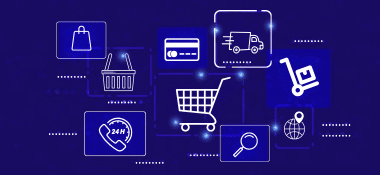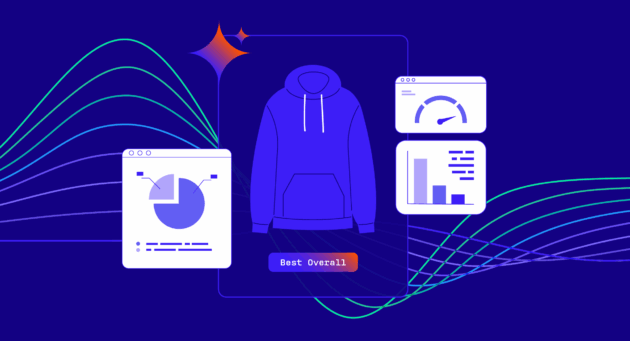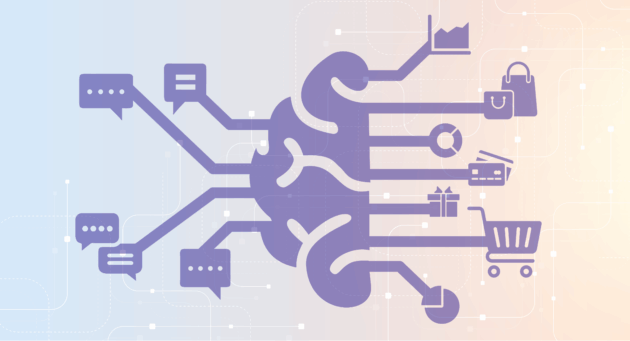- A New Signal in the AI Landscape
- From Assistants to Agents: A Commerce Evolution
- The Data That Powers Intelligent Commerce
- Beyond Crawlers: The Power of Commerce Data
- Responsible Agent Enablement
- Three Use Cases for the Agentic Future
- Building the Infrastructure for Agentic Commerce
- Leading the Industry Forward
A New Signal in the AI Landscape
Cloudflare’s move to restrict AI crawlers from accessing publisher content is a commendable step toward protecting creators in the age of generative AI. But it also highlights a broader truth: The creators shaping the future of commerce — retailers, brands, marketplaces, and even the agents themselves — are absent from the current conversation. These creators are not just content producers; they are the architects of product experiences, curators of shopper journeys, and validators of quality.
While Cloudflare’s approach focuses mainly on traditional content domains, it’s inevitable that AI crawlers will include less conventional sources such as social platforms, influencer ecosystems, and commerce environments. But crawlers can only see what is publicly posted. The most valuable commerce data — the kind that powers real-time recommendations, dynamic pricing, and personalized experiences — is held in trust by retailers, brands, and platforms like Criteo.
We believe the future of commerce will be shaped more by those who can empower AI responsibly, transparently, and inclusively, than by those who try to block it. And that means building connective tissue between AI platforms and the private, high-fidelity data that drives the sale of products. Let me be clear: This isn’t about ignoring the power of the content created by our thousands of publishing partners, many of whom were quoted in Cloudflare’s announcement. And this isn’t just about enabling AI. It IS about enabling the entire ecosystem — makers and marketers of products, retailers and marketplaces, content creators, and the agents themselves.
From Assistants to Agents: A Commerce Evolution
AI is already transforming how we work and shop. Generative tools are helping consumers make smarter decisions, and AI assistants like ChatGPT, Perplexity, and Claude are enabling more contextual, conversational search. But this is just the beginning.
As these assistants evolve into agents, which will be capable of taking action on behalf of consumers, the stakes rise. Booking a trip, buying a gift, planning a party: these are no longer just prompts, they’re delegated tasks. And the quality of these outcomes depends entirely on the quality of the data behind them.
That’s where Criteo comes in.
The Data That Powers Intelligent Commerce
AI models aren’t inherently intelligent. They require structured, enriched, and actionable data to perform at a high level. In commerce, that means more than just product listings that could be crawled. It means real-time inventory, pricing, availability, sourcing, sustainability attributes, and more — all normalized across thousands of retailers and updated continuously.
Criteo has unmatched access to one of the world’s most comprehensive commerce datasets. With over 720 million daily active shoppers interacting with 4.5 billion product SKUs and powering $1 trillion in annual transactions, the data we operate is the foundation for Commerce AI that’s both deep and wide.
But what sets us apart isn’t just scale, it’s structure. We’ve already done the hard work of normalizing this data for our own AI product recommendation, audience, and bidding models, making it an ideal source for large language models (LLMs) and agentic platforms. And because we operate with privacy and relevance at the core, we can offer this data in a way that’s secure, compliant, and aligned with each partner’s goal.
Beyond Crawlers: The Power of Commerce Data
Unlike crawlers, which rely on publicly available content, Criteo operates with access to non-public, holdout data from our partners. This includes pre-training data, real-time signals, and reinforcement feedback loops that crawlers simply cannot reach.
This is the core of our connective tissue strategy. We’re building APIs that allow AI platforms to access this data securely, enabling assistants and agents to cite the most relevant SKU in a response based on real-time filters like stock, pricing, and sales velocity.
This isn’t hypothetical. It’s already happening. Criteo AI and data science teams have already gone well beyond product metadata to behavioral embeddings, purchase groupings, and outcome tracking across millions of daily shopping journeys to create a closed-loop system where AI suggestions will lead to real-world actions, which in turn refine the model being used.
Responsible Agent Enablement
We’re already seeing the impacts of personal AI assistants on product discovery over traditional search, and we’re seeing early wins on retail and marketplace domains. Because it’s apparent that these assistants will become a new interface for commerce, trust becomes paramount.
Consumers will rely on assistants — and later agents autonomously — to make decisions, but they’ll also seek validation. That’s where retailers and marketplaces play a critical role, not just as sellers, but as validators of quality, curators of options, and providers of real-world testing and data.
One can theorize that the commerce ecosystem will evolve from personal assistants to a decentralized network of agents representing brands, retailers, and third-party certifiers. This network would enable real-time demand insights, agile logistics, and a new kind of advertising. One that informs agents rather than interrupts consumers.
Retailers who embrace this shift would become indispensable partners in the AI-powered consumer journey. And Criteo will be there to support them, providing the infrastructure, data, and monetization tools they need to thrive.
Three Use Cases for the Agentic Future
To bring our vision to life, we’re focused initially on three core use cases:
1. Prompt-Based Product Recommendations
We’re building a product grid that enables AI assistants to deliver precise, real-time recommendations based on prompts like:
“Find me a gift under $50, that’s eco-friendly, and available for delivery by Friday.”
No one else offers vectorized product metadata and shopper journey data at Criteo’s scale, accuracy, or with the reinforcement loop we enable. This will allow AI platforms and branded agents to surface best-matching products across retailers, layered with sustainability attributes and real-time inventory.
2. Smarter, Real-Time Audience Activation
As shopper journeys become more fragmented and conversational, targeting must shift from static segments to context-rich signals. We’re working to enable brands and agencies to generate the perfect audience on demand, without waiting for cumbersome data workflows and manual queries that have defined the last few years of our space.
This means faster campaign turnarounds, sharper precision, and audience activation that aligns seamlessly with both real-time intent and casual interest.
3. Agent-Enabled Full-Funnel Campaigns
We’re also enabling media activation in new environments. By embedding marketing capabilities directly into agent interfaces, we will empower marketplaces and merchant networks to execute full-funnel, cross-channel campaigns with ease.
This is about giving agents the ability to design, launch, and optimize campaigns in real time, turning them into true marketing partners.
Building the Infrastructure for Agentic Commerce
To support this future, Criteo is developing Model Context Protocol (MCP) support for these and other commerce use cases. Using MCP is a beachhead for delivering product and shopper information to AI agents in a way that is:
- Real-Time: Continuously updated with accurate pricing, availability, and enriched attributes.
- Structured: Optimized for inference precision of the querying AI agent.
- Controlled: Accessible only to authorized AI agents and platforms based on clearly defined partner terms.
Our infrastructure ensures that brands and retailers can participate in the AI ecosystem with confidence, knowing their data is secure, responsibly used, and aligned with their business objectives.
Leading the Industry Forward
At Criteo, we don’t just want to adapt to the future of AI-assisted and agentic commerce; we want to lead it. That means reducing hype, focusing on concrete use cases, and building a scaled marketplace with trading liquidity that both resolve the best consumer shopping journey. We’re not just connecting products to people. We connect interest and intent to outcomes, data to decisions, and agents to the ecosystem they serve. For the love of commerce.
Find out more about how our AI is fueling the next generation of commerce through deep learning.
Forward-Looking Statements Disclosure
This blog post contains forward-looking statements, including our expectations regarding our market opportunity and future growth prospects and other statements that are not historical facts and involve risks and uncertainties that could cause actual results to differ materially. Factors that might cause or contribute to such differences include, but are not limited to: failure related to our technology and our ability to innovate and respond to changes in technology, uncertainty regarding our ability to access a consistent supply of internet display advertising inventory and expand access to such inventory, investments in new business opportunities and the timing of these investments, whether the projected benefits of acquisitions or strategic transactions materialize as expected, uncertainty regarding international operations and expansion, including related to changes in a specific country’s or region’s political or economic conditions (such as changes in or new tariffs), the impact of competition or client in-housing, uncertainty regarding legislative, regulatory or self-regulatory developments regarding data privacy matters and the impact of efforts by other participants in our industry to comply therewith, the impact of consumer resistance to the collection and sharing of data, our ability to access data through third parties, failure to enhance our brand cost-effectively, recent growth rates not being indicative of future growth, client flexibility to increase or decrease spend, our ability to manage growth, potential fluctuations in operating results, our ability to grow our base of clients, and the financial impact of maximizing Contribution ex-TAC, as well as risks related to future opportunities and plans, including the uncertainty of expected future financial performance and results and those risks detailed from time-to-time under the caption “Risk Factors” and elsewhere in Criteo’s SEC filings and reports, including Criteo’s Annual Report on Form 10-K filed with the SEC on February 28, 2025, and in subsequent Quarterly Reports on Form 10-Q as well as future filings and reports by Criteo. Importantly, at this time, macro-economic conditions including inflation and fluctuating interest rates in the U.S. have impacted and may continue to impact Criteo’s business, financial condition, cash flow and results of operations.
Except as required by law, Criteo undertakes no duty or obligation to update any forward-looking statements contained in this release as a result of new information, future events, changes in expectations or otherwise.
















